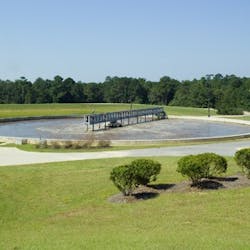BNR System Provides Three Process Phases in One Basin
The Schreiber Continuously Sequencing Reactor (CSR) is a biological nutrient removal (BNR) system contained in a single basin. It sequences through the three process phases required for BNR—oxic, anoxic and anaerobic—in one basin. The three phases do not occur at the same time in the basin; they occur sequentially—one after the other, repetitively, over time.
For the CSR, the secret to this “phase sequence-ability” lies in its unique design for complete separation of aeration and mixing. It has a 100% aeration turndown capability; this important feature allows the aeration to be turned completely off while the CSR applies its low-energy mixing without aeration. The contents of the basin are mixed as the rotating bridge moves around the basin. Retrievable diffuser support components and diffuser units suspended from the bridge provide the driving force for complete mixing. Close proximity of these components to the tank bottom provides localized scouring to maintain suspension of solids. As a result, the power requirement for mixing is 2.5 to 3.5 hp/million gal.
Through the use of Schreiber FlexControls, the CSR process can be advanced to meet stringent requirements for today and the future.
Contact Us
Schreiber LLC
Trussville, AL
205.655.7466
www.schreiberwater.com
